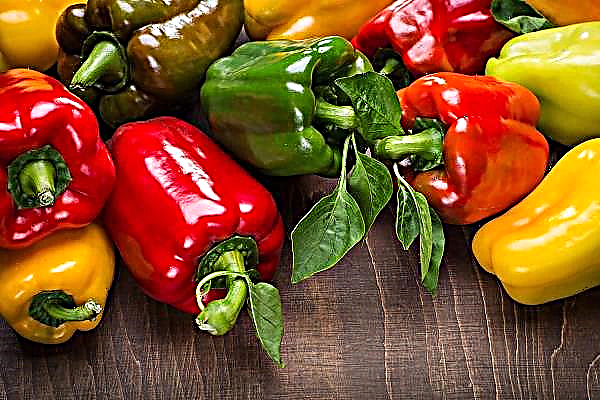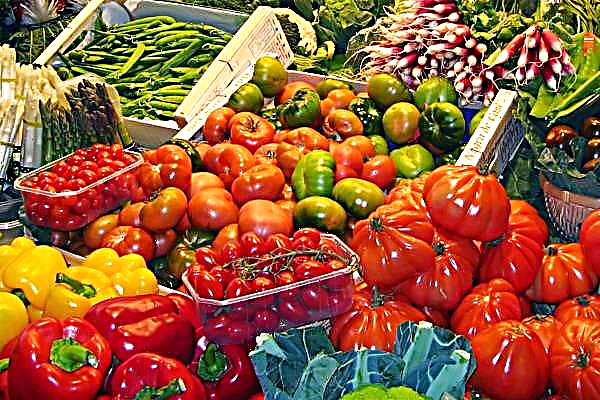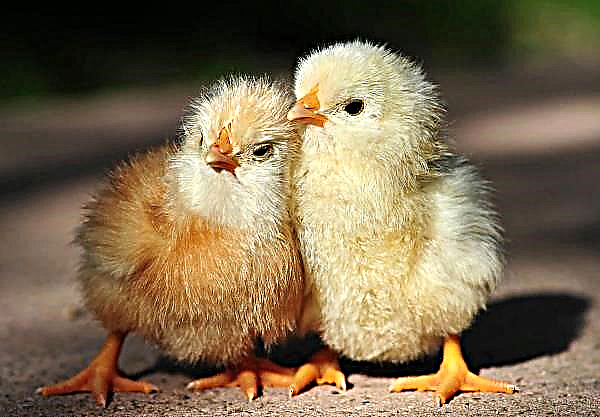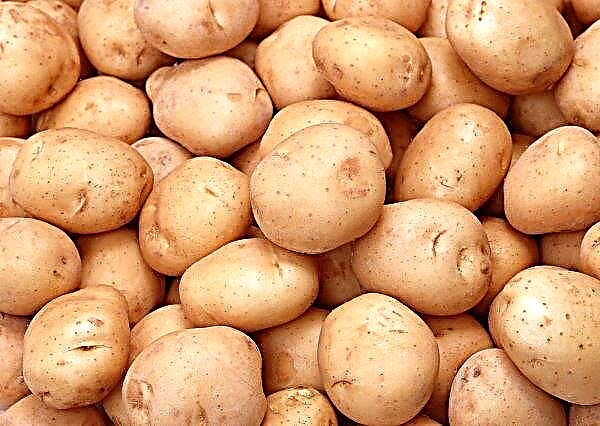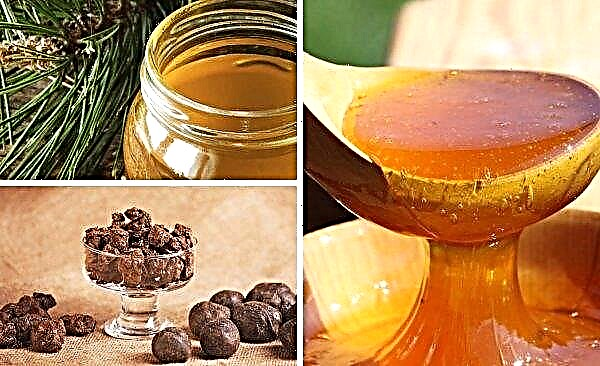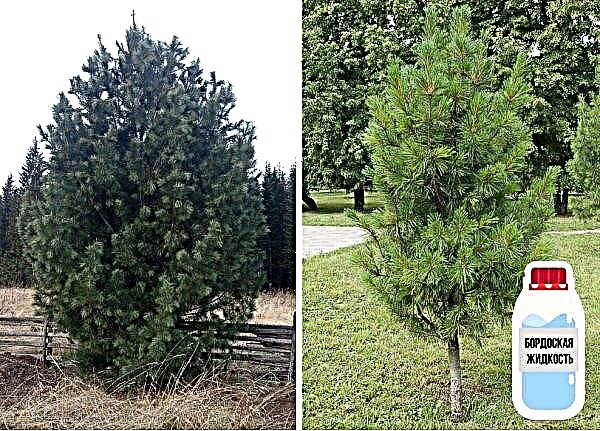Fans of large-fruited tomatoes should pay attention to the variety with the original name "Japanese crab". In addition to a very unusual shape, these tomatoes, bred by Siberian breeders at the end of the last century, are rightfully considered one of the best in taste. In addition, the "Japanese crab" has many other advantages over other varieties and hybrids, which are described in detail in this review.
Grade description
"Japanese crab" is a tall indeterminate tomato variety of medium maturity. Large seven-chamber fruits of pink color and a bizarre shape, due to which the tomato got its name (from the top to the bottom along the entire length of the tomato is divided by grooves resembling crab claws), appear approximately at the end of the third month after the appearance of the first shoots. The weight of one tomato is on average 400 g, but larger fruits are formed on the lower brushes of the bush, reaching 500 g and even more.
Did you know? In Japan, to which the tomato variety in question has nothing to do with reality, cucumbers and tomatoes are well known and loved. But only fresh. The pickles traditional for our winter table are not harvested there.
Siberian breeders also managed to achieve impressive crop yields: up to 7 kg of fruits can be removed from one bush with good care.
A distinctive feature of the variety is the taste of the fruit. Their juicy, dense and at the same time tender flesh is perfect for salads. In addition, "Japanese crab" can be used for the preparation of juices, ketchups, pastes and other preparations for the winter.
Photo gallery
The variety is recommended for cultivation in all regions of the middle lane, but if in the south it is more suitable for open ground, then in cooler areas it is recommended to grow it under film shelter.
The bush can grow up to one and a half meters (under especially favorable conditions - even up to two). The foliage is good, the leaf plate is light green in color, the sizes are average, the inflorescences are simple.
Advantages and disadvantages
- Gardeners and farmers with experience in the cultivation of "Japanese crab", note the following advantages of the variety:
- unpretentiousness and versatility (the variety is equally well suited for growing in open ground or under the film);
- good germination of seeds (up to 95%);
- excellent taste;
- very unusual shape of the fruit;
- impressive tomato sizes;
- high productivity and long fruiting (tall bush develops throughout the season, forming more and more fruit brushes, right up to the first frosts);
- the ability to use the fruits fresh, as well as for preservation (in the form of juice, pasta, as well as in other preparations involving the chopping of tomatoes);
- the availability of seed material (this is a full-fledged variety of tomatoes, not a hybrid, therefore, the collected seeds during their subsequent planting fully preserve the qualities of the mother plant, and there is no need to acquire new seeds every year);
- resistance to cooling and many diseases that are dangerous for other varieties of tomatoes (primarily tobacco mosaic, late blight, as well as leaf and root rot).
- Speaking about the disadvantages of the variety, farmers say:
- low shelf life of the fruit, which makes them poorly suitable for long-term storage and transportation;
- poor resistance to heat and drought;
- incomplete ripening of the fetus over the entire area (in the area of the stalk, a dense green zone often remains, which has to be cut and removed);
- high requirements for observing the rules of agricultural technology - mulching, top dressing, trunk formation, garter;
- direct dependence of the crop on weather conditions (at high humidity and low temperatures, the bushes survive, but the fruits are poorly tied);
- the inability to preserve the whole because of the large size;
- the risk of crop loss with a sharp drop in temperature during the laying of buds and flowering.
Sowing seeds for seedlings
Japanese crab, like other large-fruited tomatoes bred in Siberia, is not necessary to grow from seedlings. The seeds of this cold-resistant variety can be sown directly in open ground. This method greatly facilitates agricultural technology, but does not make it possible to obtain an earlier crop, since the seeds will not germinate in cold soil until winter recedes completely.  The seedling method allows, at the same time, to obtain sufficiently strong and formed bushes that, after planting in the open ground, will literally begin to tie the first flower brushes in a few days.
The seedling method allows, at the same time, to obtain sufficiently strong and formed bushes that, after planting in the open ground, will literally begin to tie the first flower brushes in a few days.
Optimal timing
Experienced gardeners know that the right moment for planting tomato seedlings is an indispensable condition for the agricultural technology of this plant.
For this reason, the timing of planting seedlings of the "Japanese crab" must be determined depending on the climatic zone, weather forecasts and, in some part, their own feelings. By the time of planting in the open ground, the bushes should form 3 pairs of true leaves and grow up to about 20–25 cm, for this, with proper agricultural technology, it takes about 2 months from the moment the seeds are planted in seedlings.Important! Planting tomato seedlings too early is a serious agrotechnical mistake, because bushes can form quickly enough and reach the size necessary for planting long before the weather is warm.

Soil mix
The soil mixture for planting seedlings is best purchased in a store: special substrates not only have an optimal composition that allows for the rapid formation of a bush and saturates it with essential nutrients, but also undergoes a special disinfection procedure. Thus, young plants in such soil are not threatened with the development of the "black leg" and other dangerous diseases, often affecting seedlings planted in ordinary garden soil.
Important! Typically, tomatoes prefer soil with a neutral reaction, with a pH level of 6.5 to 7, but Siberian large-fruited plants grow better in more acidic soil.
If it is decided to prepare the soil for seedlings on your own, you should be guided by the fact that the "Japanese crab" prefers light and porous loam, which, both during germination and subsequently, will be well heated and ventilated. According to the reaction, the soil should be acidic or slightly acidic (pH level in the range from 5 to 5.5). You can prepare the mixture using:
You can prepare the mixture using:
- organic components (turf or leafy land, compost, humus, moss, peat, wood ash);
- inorganic additives (sand, perlite, vermiculite, expanded clay, etc.).
Next, a self-prepared soil mixture must be decontaminated. This can be done in different ways, for example:
- placing the soil for several days in open air in severe frost (it is advisable to wait until the temperature drops below –10 ° C), then let the soil warm up well at room temperature so that the dormant pests and pathogens in it become active, and then repeat the procedure;
- warm the earth for half an hour in an oven heated to 90 ° C (higher temperatures can kill the beneficial microflora in the soil, which should never be allowed;
- hold over boiling water for several minutes (you can use a water bath);
- pour a weak solution of potassium permanganate.
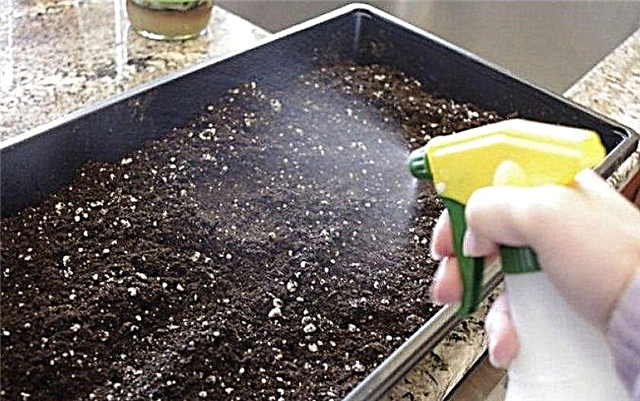 After any disinfection procedure, the substrate must be kept at normal room temperature for at least a day, so as not to kill the embryo in the seed as a result of a burn (thermal or chemical) or hypothermia.
After any disinfection procedure, the substrate must be kept at normal room temperature for at least a day, so as not to kill the embryo in the seed as a result of a burn (thermal or chemical) or hypothermia.
Container for growing
For planting seedlings, you can use any suitable container (for example, wooden or plastic boxes), but it is most convenient to work with special cassettes at the initial stage. In garden stores or on the Internet there is a huge selection of such products made from high quality polyvinyl chloride.
- The advantages of such a container include the fact that it:
- does not contain toxic substances;
- has strong sides and is very convenient for transportation;
- perfectly matched to the dimensions necessary for the formation of the root system of one bush.
Dutch and Polish cassette standards (54 × 28 cm and 40 × 60 cm, respectively) are well suited for tomatoes. There are cassettes in which seedlings will be grown up to planting in open ground (the volume of one cup in them is approximately 300 cm²), from other, smaller, grown seedlings it will be necessary to dive into separate cups or peat tablets.  Plastic cassettes for seedlings. The last option is very convenient, since it does not involve removing an earthen coma from a container during planting in open ground (the bush sits with the “pot” in which it grew), but such a product is expensive, given the impossibility of its reuse, .
Plastic cassettes for seedlings. The last option is very convenient, since it does not involve removing an earthen coma from a container during planting in open ground (the bush sits with the “pot” in which it grew), but such a product is expensive, given the impossibility of its reuse, .
Seed preparation
An important step in planting seedlings, which is often ignored by inexperienced gardeners, is the preparation of seed material.
Preparation of tomato seeds includes four stages:
- selection;
- disinfection;
- rooting stimulation;
- quenching.

To kill the pathogenic microflora that can persist on the surface of the seeds, they should be held for 10-20 minutes in a disinfecting medium, for example:
- weak pink solution of potassium permanganate;
- 2% hydrogen peroxide solution, heated to a temperature of +40 ... + 45 ° C (it feels like very hot water, in which you can drop your finger for a while);
- freshly squeezed aloe juice.
For hardening, seeds are laid out between several layers of gauze soaked in a nutrient solution, which is placed in a plastic bag. In this condition, the seeds are kept for a day in a very warm place (you can put it on a central heating battery if it is not so hot that you can not touch it, otherwise you should use a pad, for example, from a towel folded into several layers). Then the same bag is put in the refrigerator for 12 hours (on the lower shelf, in the vegetable compartment). After a while, the contrast procedure is repeated - in total they need to be carried out 2-3 times, constantly monitoring so that the gauze in which the seeds are wrapped remains wet.
Then the same bag is put in the refrigerator for 12 hours (on the lower shelf, in the vegetable compartment). After a while, the contrast procedure is repeated - in total they need to be carried out 2-3 times, constantly monitoring so that the gauze in which the seeds are wrapped remains wet.
Seeds prepared in this way show much higher resistance to temperature changes, germinate faster and get sick less.
Sowing seeds
Tomato seeds are usually laid in the soil to a depth of not more than 1 cm. There are two ways to ensure this. The first involves the preparation of a hole (if cassettes are used) or grooves (for landing in boxes) of the desired depth. But it is much simpler and more reliable to use the second method: first, part of the soil mixture (about 2/3 of the depth of a standard container) is poured into the tank, which must be immediately watered well. Then, seeds are laid directly on the surface, after which a centimeter layer of the substrate is carefully refilled from above. This method allows you to place the seeds at exactly the same depth, which will be well controlled.
Important! After laying the seeds, the soil is no longer watered to prevent uncontrolled deepening of the seeds along with water.
1 seed is placed in small cassettes, 2 or 3 can be placed in larger ones. When planting in boxes between rows, 3-4 cm are kept, between adjacent seeds in a row - 1-2 cm. However, you need to understand that in reality the frequency of planting tomatoes at this stage it does not matter, just the less sowing is done, the greater the period of time can pass before the moment of diving. The only thing that needs to be monitored is to prevent the spreading of seeds in close proximity to each other, since if two shoots appear from one point, it will be practically impossible to separate one from the other without damaging the gentle root of the “neighbor”.
Video: Sowing seeds for seedlings
Seedling Care
Before germination, the containers with planted seeds should be covered with a plastic film (or glass) and kept at a temperature of +25 ... + 30 ° C. At home, the optimal place for germination is close proximity to a heat source. The ground under the film must be constantly moistened with a spray gun, while spraying it to provide a ventilation element that is very important for preventing the formation of mold and other fungi on the soil surface. As soon as green sprouts appear on the surface, and this moment usually occurs 5-7 days after planting, the film is removed, but not sharply, but gradually, over the course of several days, increasing the time the sprouts stay outside the "greenhouse".
The optimum temperature for tomato seedlings is +20 ... + 25 ° CAt the same time, it is desirable that the plants do not feel a big difference between the day and night temperature conditions and in no case are exposed to a cold air stream (the windows on which the seedlings are exposed cannot be opened for the first time). Since at the end of winter or the beginning of spring, when tomatoes are planted, even on the lightest window sill it is usually still not sunny enough, many professional gardeners use the artificial lighting regime for young bushes.
Since at the end of winter or the beginning of spring, when tomatoes are planted, even on the lightest window sill it is usually still not sunny enough, many professional gardeners use the artificial lighting regime for young bushes.
Important! Modern technologies for germinating tomato seedlings are based on the fact that during the first 3 days after germination the seedlings are provided with round-the-clock lighting, and starting from the 4th day - 16 hours is enough.
During the first weeks, it is important to prevent the drying of the soil in which the seedlings are located. The moisture in this period in the earth should be not just a lot, but a lot. When the sprouts get stronger, watering can be reduced and carried out only as the top layer of the soil dries. This should be done very carefully so as not to damage the delicate parts of the plant. For such purposes, a disposable syringe without a needle is very suitable. The general rule is universal: the more heat and light, the more water the seedlings need (and the faster it grows). By the way, wilted leaves and stems of young tomatoes that have completely fallen to the ground can indicate both overdrying and overflow, so it is important to balance between these two extremes.
Approximately 2 weeks after emergence, the tomatoes can be fed organics for the first time (for example, compost or manure, humates can also be used, the most popular of them is called “Biohumus”, however, the concentration recommended by the manufacturer should be reduced by half). In the subsequent feeding can be repeated every 7-10 days. When the bushes formed the first pair of true leaves, it was time to plant them in separate containers (if cassettes with large cells were used to grow seedlings, in which one seed was planted, picking can be omitted). The procedure should be carried out with extreme caution so as not to injure the root of the young plant.
When the bushes formed the first pair of true leaves, it was time to plant them in separate containers (if cassettes with large cells were used to grow seedlings, in which one seed was planted, picking can be omitted). The procedure should be carried out with extreme caution so as not to injure the root of the young plant.
Important! Root clipping by a third leads to stunting for about 7 days.
Seedling hardening
About 2 weeks before the expected date of planting seedlings in open ground, you need to prepare young bushes for a future cardinal change in external conditions. For this, seedlings must first be taken out for short periods of time (about an hour in the middle of the day) in the open air or, if this is not possible, left by an open window. Then the time gradually increases so that by the time of transplantation to a permanent place, the seedlings can already remain without problems in the open air throughout the day and all night.
Planting seedlings in a permanent place
When determining the moment the Japanese Crab variety is planted in open ground, it should be assumed that a temperature drop of up to +4 ° C can completely destroy already formed ovaries. For this reason, it is better to wait until the average daily temperature drops below +10 ° C, only in this mode the soil will be warm enough. Depending on the climatic zone, this period may occur in April, or maybe in May and even the beginning of June.
Did you know? The famous Russian agronomist N. I. Kurdyumov is the author of the “smart garden” idea - plants are planted in narrow (no more than half a meter) trenches, the lower layer of which consists of decaying and heat-releasing organics.
Well, if by the time of planting on the young bush the first flower branch has already been laid, but the appearance of flowers on seedlings should not be allowed.
The standard pattern for planting tall "Japanese crabs" is 50 cm between rows and 40 cm between bushes in one row, so that 3-4 bushes are placed on 1 m².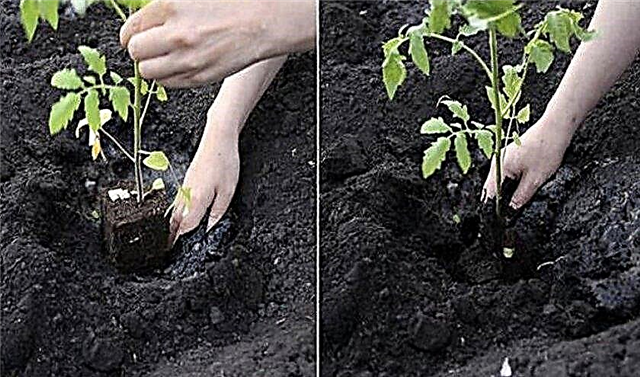 It is very important to choose a sunny place for tomatoes and to introduce a sufficient amount of organic fertilizers into the soil. In addition, before planting, you should think in advance about the scheme of future support, since tall bushes with large fruits will break off without additional support.
It is very important to choose a sunny place for tomatoes and to introduce a sufficient amount of organic fertilizers into the soil. In addition, before planting, you should think in advance about the scheme of future support, since tall bushes with large fruits will break off without additional support.
How to care
Many summer residents who tried to grow the "Japanese crab", express a sharply negative attitude to the variety. The problem is that the yield of a variety can be ensured only if it strictly adheres to the necessary agro-technical conditions.
Watering
Siberian breeders recommend watering the "Japanese crab" once every 1-2 weeks, but in the conditions of a dry summer prevailing in the more southern regions, this frequency is not enough. Therefore, it is necessary to be guided in this regard by the state of the soil: as its top layer dries, watering is carried out.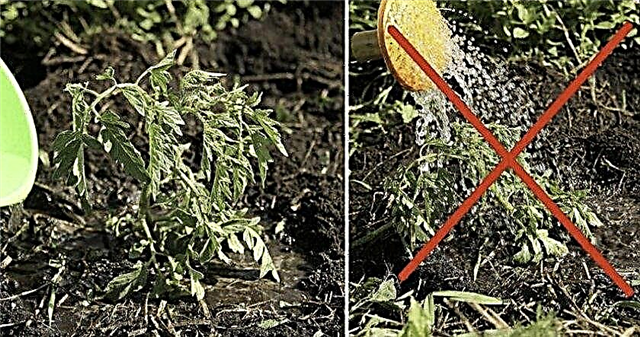 For the "Japanese crab", the general rules applicable to watering with all tomatoes are relevant, namely:
For the "Japanese crab", the general rules applicable to watering with all tomatoes are relevant, namely:
- you should never water a plant on top of foliage, especially you can not do it under the bright sun;
- for watering, you need to use water of the same temperature, which is retained on the soil;
- The ideal form of irrigation, both from the point of view of preventing waterlogging and from the point of rational use of water, is the drip irrigation system (in this case, watering can be turned on even during the day, it is not necessary to wait until sunset).
Top dressing
If the soil under the tomatoes is sufficiently fertile and enriched with organic matter, and the seedlings were grown correctly, to ensure good yield of the "Japanese crab" it is enough to carry out no more than 2-3 feeding during the entire growing season. For this purpose, you can use any mineral fertilizer, with one caveat: after the start of the fruit laying period, the nitrogen content in the fertilizer should be reduced, otherwise all the forces of the bush will be directed to the formation of green mass, and the tomatoes will be small and rare.
Important! With a lack of lighting, tomatoes are especially in need of potash fertilizers.
The first top dressing is carried out a month after transplanting seedlings in open ground, the second - with the beginning of fruiting and the third, if necessary - another month or a half later.
Stepson
"Japanese crab" grown in open ground, it is recommended to form in one or two stems (the second stem is derived from the stepson, who grew above the first leaf). In regions with a colder climate, it is better to focus on leaving a single trunk, since the crop, which is formed on two stems at once, simply does not have time to ripen before the end of a short and warm summer. The remaining stepchildren (shoot primordia that form above each leaf up to the first fruit brush) should be carefully plucked as they appear. To obtain a higher yield and protect the bush from the development of fungal diseases, it is also very important to remove dried branches and leaves in time.
To obtain a higher yield and protect the bush from the development of fungal diseases, it is also very important to remove dried branches and leaves in time.
Soil care
Weeding and loosening the soil after each irrigation to avoid the appearance of cracks on it, through which moisture that has fallen into the soil actively evaporates, are standard procedures for the traditional cultivation of tomatoes in the garden.
Modern technologies can significantly simplify the work of the gardener, while ensuring a much higher productivity of the crop. So, the usual drip irrigation system (it is not at all difficult to install it, all the necessary equipment is commercially available and inexpensive) allows you to solve the loosening problem: with this method of watering, the soil around the bush does not crack. If you mulch the beds with hay, peat or needles, you can not only save moisture in the soil for a long time, but also get rid of weeds.
Video: Advantages and disadvantages of replacing agrofibre
Another way to combat weed is to plant tomatoes on top of black agrofibre: the material is lined on top of the harvested beds, then a cross-shaped incision is made in the fabric in the place of planting the future bush, the fiber is bent, a hole is dug in the resulting hole, and after planting the bush in it, the edges fold back .
Nevertheless, no matter what method of soil care you choose, the rule remains the same: there should be no weeds in the bed with tomatoes, and the earth around the bush should not be as hard as stone, after the water poured onto it has dried.
Bush tying
You need to tie the "Japanese crab", otherwise branches with large fruits will lie on the ground and even if the bush does not break, the tomato will not be able to fully and evenly ripen. Of course, if only 5 bushes are planted in the garden, you can carefully drive a peg near each of them and tie the trunk to this simple support. However, when occupying larger areas, such a method of strengthening bushes is unprofitable. Modern agrotechnology for growing tall tomatoes offers three main methods of garter:
Modern agrotechnology for growing tall tomatoes offers three main methods of garter:
- trellis (at the beginning and at the end of the bed stable columns are driven in, strong threads are stretched between them in several tiers, trunks are tied to them);
- cells (individual wire frames that are installed next to each bush and are reusable);
- caps (tapering up frames from improvised means with which each bush is covered).
Preventative treatment
"Japanese crab" is a variety that initially shows increased resistance to fungal infections and pests, therefore, when creating favorable conditions for tomato, there is no urgent need for carrying out preventive treatments of beds. However, if the summer was rainy and the nights are cool, to prevent the development of late blight, the bushes are recommended to be treated 2-3 times with a three-day break with Fitosporin, Trichopolum or a solution of wood ash. If the air humidity is too high, the tomatoes are at risk of cladosporiosis (brown spotting). To prevent this disease, you can use folk remedies (for example, a weak solution of potassium permanganate, the same solution of wood ash or a special recipe: 25 drops of iodine and a liter of cow's milk per bucket of warm water) or modern drugs. Among these are Bravo, NeoTech and others. A solution of copper sulfate, colloidal sulfur and polycarbacin (1 tbsp., 3 tbsp. And 1 tbsp. Per bucket of water, respectively) is also used to prevent brown spotting.
To prevent this disease, you can use folk remedies (for example, a weak solution of potassium permanganate, the same solution of wood ash or a special recipe: 25 drops of iodine and a liter of cow's milk per bucket of warm water) or modern drugs. Among these are Bravo, NeoTech and others. A solution of copper sulfate, colloidal sulfur and polycarbacin (1 tbsp., 3 tbsp. And 1 tbsp. Per bucket of water, respectively) is also used to prevent brown spotting.
Among the pests that can attack the "Japanese crab" during the season, it is worth remembering first of all:
- Colorado potato beetle;
- bug bug;
- a bear;
- whitefly;
- wireworm;
- scoop;
- aphids (cotton or melon);
- nematode;
- thrips;
- solanaceous miner;
- spider mite.
 When the first signs of parasites appear, you can try to treat the bushes with soapy water or saturated infusions of wormwood, yarrow, tobacco, garlic or chamomile. There is an option to use modern biological products that act specifically on the pest and are safe for humans. For example, such drugs include Verticillin, Bitoxibacillin, Boverin, Guapsin.
When the first signs of parasites appear, you can try to treat the bushes with soapy water or saturated infusions of wormwood, yarrow, tobacco, garlic or chamomile. There is an option to use modern biological products that act specifically on the pest and are safe for humans. For example, such drugs include Verticillin, Bitoxibacillin, Boverin, Guapsin.Harvesting
"Japanese crab" refers to mid-season tomatoes, and this is the value of this variety: before they reach technical maturity, tomatoes manage to gather enough nutrients and vitamins, which is never observed in early tomatoes.
The first ripe fruits of the Siberian variety can be removed approximately 3.5 months after germination, that is, already 1.5–2 months after planting in open ground. If the agrotechnology of tomato cultivation is perfectly maintained, Japanese Crab will delight with delicious large tomatoes during the second half of summer - the first half of autumn, and in warm regions it can bear fruit until November. The problem, however, is that tomatoes of this variety, due to their large size and irregular shape, are very poorly stored, so you need to eat or process them almost immediately after harvesting.
The problem, however, is that tomatoes of this variety, due to their large size and irregular shape, are very poorly stored, so you need to eat or process them almost immediately after harvesting.
Tomato "Japanese crab" refers to varieties that require enough attention and strength. But if the necessary conditions are created, the gardener will receive tomatoes, whose taste qualities are beyond praise, as a worthy reward for their labors.




